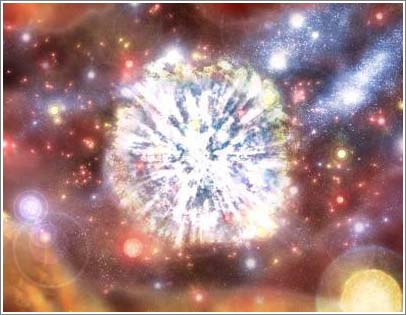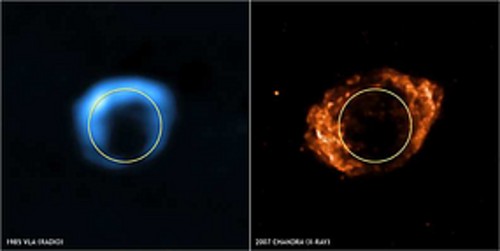Discovering a newborn supernova near us
A newly formed supernova (a star who died before death), just over a century old, has just been found in our Milky Way.

Supernova image G1.9 + 0.3.White shows fragments spreading after the explosion.Surrounded by gas, dust, and many stars with different colors and sizes.(Photo: NASA / CXC / M. Weiss)
The discovery opens an unprecedented opportunity to observe a dying star.
This supernova, called G1.9 + 0.3, flared brightly in its first explosion 140 years ago, but no one saw it because of the vision, David Green, from Cambridge University. He, and his colleagues announced.
"So far this is the youngest supernova identified in our galaxy," Green said.
Green first identified the object in 1985 with radio data, and said it could be a supernova. In 2007, Stephen Reynolds from North Carolina State University, thanks to Chandra X-ray observatory, was surprised to find it 16% larger than radio measurements.

Left photo : Supernova image G1.9 + 0.3 taken by the radio observatory Very Large Array of NRAO in 1985. Right photo : Photograph taken by NASA's Chandra X-ray observatory early 2007. Differences The size of the supernova between the two photographs is a clear evidence for scientists to estimate the time of the explosion about 140 years ago. (Photo: NASA)
"The only logical explanation we can, is that after this 22-year period between observations, this star has expanded in that proportion," Reynolds said.
This supernova is located in the center of our galaxy, about 25,000 light-years from Earth.
Reynolds said the discovery re-questions the question of why so many supernovae are found in the Milky Way. Maybe, it's because cosmic dust has covered most of them.
Scientists believe that understanding a young supernova may help to understand the early days of life. "Supernova creates a chemical element through real alchemy - transforms an element into another element," they say. For example, the iron element in the blood, was born by such a star.
"Our planet, our cells, our body parts are made up of ash that has disappeared in those supernova explosions," said Robert Kirshner, from the Smithsonian Astrophysics Center, Harvard University, said.
- Build 3D core map of a supernova
- Learn about supernovae and supernovae
- Discover new supernova
- Photos, videos and three-dimensional models of giant supernova
- Create supernova explosions in the laboratory
- June 8: Titan Arum superhuman first hatches, discovering the brightest planet in the universe
- The supernova explosion is 10.5 billion light-years away from Earth
- The supernova is 20 times brighter than the Milky Way
- Discover new forms of supernovae
- Supernova origin
- Earth used to catch supernova dust
- NuSTAR telescope helps decode supernova explosions
 Van Allen's belt and evidence that the Apollo 11 mission to the Moon was myth
Van Allen's belt and evidence that the Apollo 11 mission to the Moon was myth The levels of civilization in the universe (Kardashev scale)
The levels of civilization in the universe (Kardashev scale) Today Mars, the sun and the Earth are aligned
Today Mars, the sun and the Earth are aligned The Amazon owner announced a secret plan to build a space base for thousands of people
The Amazon owner announced a secret plan to build a space base for thousands of people Discovery of space object powerful enough to tear apart the Earth
Discovery of space object powerful enough to tear apart the Earth  The most complete picture of an extremely rare supernova
The most complete picture of an extremely rare supernova  Unparalleled treasure in Egypt: Being 'molded' from many alien worlds
Unparalleled treasure in Egypt: Being 'molded' from many alien worlds  The dazzling supernova destroys a massive cloud of gas
The dazzling supernova destroys a massive cloud of gas  The universe 'scarce' phosphorus, and aliens are not as much as we expected
The universe 'scarce' phosphorus, and aliens are not as much as we expected  Close-up of cosmic vampires
Close-up of cosmic vampires 